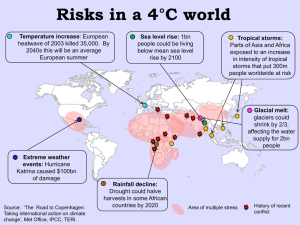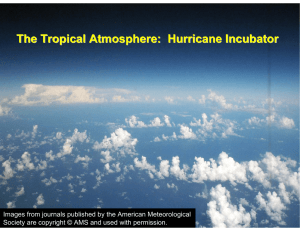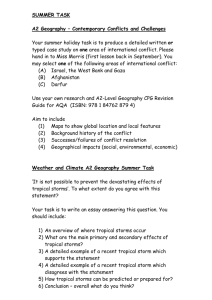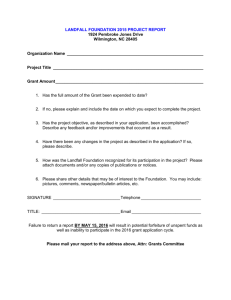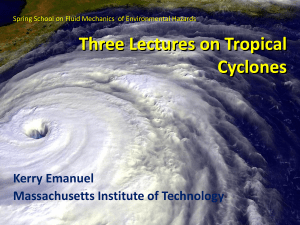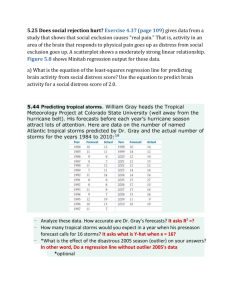Document 13567989
advertisement
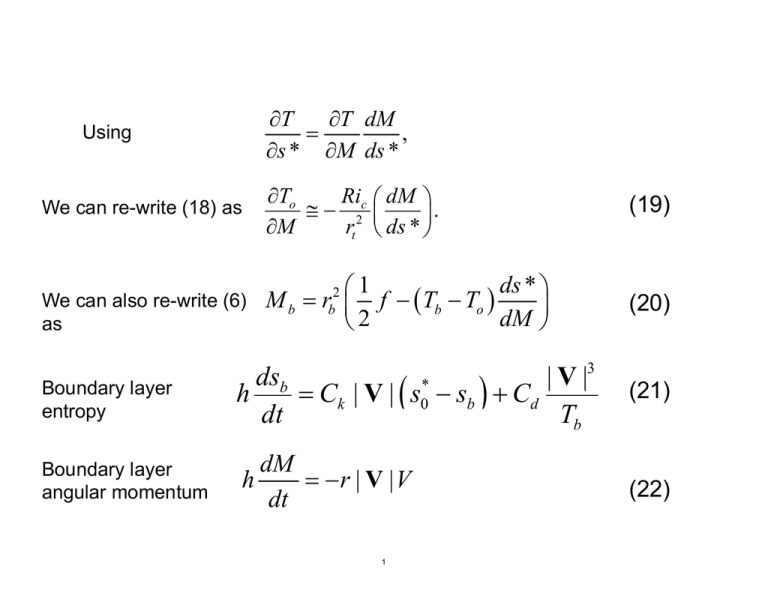
T T dM , s * M ds * Using We can re-write (18) as To Ri dM 2c . M rt ds * ds * 1 We can also re-write (6) M b r f Tb To 2 dM as 2 b Boundary layer entropy Boundary layer angular momentum 3 V dsb | | Ck | V | s0* sb Cd h dt Tb dM h rr | V | V dt 1 (19) (20) (21) (22) Combine (21) and (22): * s dsb Ck 0 sb | V |2 dM CD rV V Tb rV V Let sb s*, | V | V Vb , r rb * s ds * Ck 0 s * Vb dM CD rV Tb rb b b (23) Balance condition (8): Vb ds * Tb To rb dM 2 (24) Eliminate Vb between (23) and (24): * s 0 s * 2 ds * Tb Ck 2 dM T C r o D b Tb To ( ) (25) Eliminate rb2 between (20) and (25): ds * f ds * 0,, 2 dM Tb To dM 2 where Remember that (26) Tb Ck s0 * s * To CD 2M To T Ric dM 2 M rt ds * 3 (19) Integrate (26) and (19) inward from some outer radius ro, defined such that V 0 at r ro In general,, inte grating g this system will not yield To=Tt at r=rmax. Iterate value of rt until this condition is met. If V >> fr, fr we ignore dissipative heating heating, and we neglect neglect pressure dependence of s0*, then we can derive an approximate closed-form solution. 4 Assuming that Ri is critical in the outflow leads to an equation for To that, coupled to the interior balance equation and the slab boundary layer lead (surprisingly!) to a closed form analytic solution for the gradient wind (as represented represented by angular momentum, M, at the top of the boundary layer: 2 M Mm C 2 k CD r 2 rm , 2 Ck Ck r 2 CD CD rm 5 (27) 2 fro2 2Vm rm C 2 k CD ro 2 rm . 2 Ck Ck ro 2 CD CD rm 1 2 1 1 Ck rm fro Vm 2 2 C D 1 C 2 k CD (28) (29) The maximum wind speed,V m , found from maximizing the radial dependence of wind speed in the solution (27) is given by C 2 k CD m V 2rm V 2 fro 2 p 6 Ck CD (30) Ck V Tb Tt s0 * se * CD 2 p Substituting (29) into (30) gives 1 Ck V V 2 CD 2 m 2 p 7 Ck CD C 2 k CD (31) Substituting (31) into (29) gives 1 rm 2 3 2 2 o fr Tb Tt s0 * se * Also, CD rt r Ric Ck 2 2 m 8 9 70 Control With dissipative heating 60 V (m/s) 50 40 30 20 10 0 0 100 200 300 400 radius di (km) (k ) 10 500 600 700 11 Numerical integrations with RE87 model (no dissipative heating heating, no pressure dependence of k0*) : Left, regular variables; Right: Velocity scaled by (31) and time scaled by the inverse square-root of the enthalpy exchange coefficient coefficient. 12 Effects of Pressure Pressure--Dependence of of Surface Saturation Enthalpy Enthalpy 13 14 15 16 17 18 00 GMT 27 April 2007 40oN 20oN o 0 20oS 40oS o 60oE 0 10 20 120oE 30 180oW 40 50 19 120oW 60 60oW 70 80 o 0 90 Relationship between potential intensity (PI) and intensity of real tropical cyclones cyclones 20 21 22 Wind speed (m/s) Potential wind speed (m/s) 80 70 60 50 V (m/s) 40 30 20 10 -80 -60 -40 -20 0 20 40 60 Time after maximum intensity (hours) 23 80 100 Evolution with respect to time of maximum intensity 24 Evolution with respect to time of maximum intensity, normalized by peak wind 25 Evolution curve of Atlantic storms whose lifetime maximum intensity is limited by declining potential intensity, but not by landfall 26 Evolution curve of WPAC storms whose lifetime maximum intensityy is limited byy declining g potential p intensityy, but not by y landfall 27 CDF of normalized lifetime maximum wind speeds of North Atlantic tropical cyclones of tropical storm strength (18 m s−1) or greater, for those storms whose lifetime maximum intensity was greater limited by landfall. 28 CDF of normalized lifetime maximum wind speeds of Northwest Pacific tropical cyclones of tropical storm strength (18 m s−1) s 1) or greater, greater for those storms whose lifetime maximum intensity was limited by landfall. 29 Evolution of Atlantic storms whose lifetime maximum intensity was limited byy landfall 30 Evolution of Pacific storms whose lifetime maximum intensity was limited byy landfall 31 Composite evolution of landfalling storms 32 MIT OpenCourseWare http://ocw.mit.edu 12.811 Tropical Meteorology Spring 2011 For information about citing these materials or our Terms of Use, visit: http://ocw.mit.edu/terms. 33
